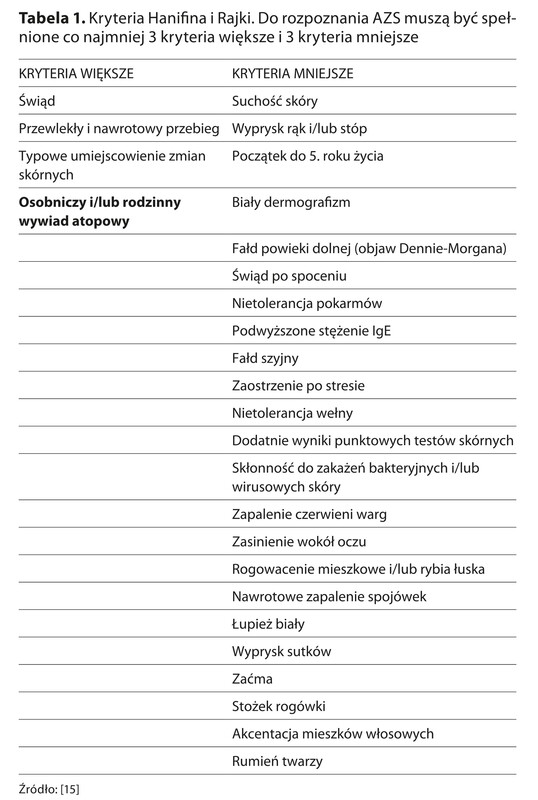REVIEW PAPER
Effect of selected dietary aspects on the development and course of atopic dermatitis
1
Wydział Lekarski, Studenckie Koło Naukowe Alergologii i Chorób Wewnętrznych, Uniwersytet Medyczny im. Piastów Śląskich we Wrocławiu, Polska
2
Katedra i Klinika Alergologii i Chorób Wewnętrznych, Instytut Chorób Wewnętrznych, Wydział Lekarski, Uniwersytet Medyczny im. Piastów Śląskich we Wrocławiu, Polska
Corresponding author
Magdalena Dederko
Wydział Lekarski, Studenckie Koło Naukowe Alergologii i Chorób Wewnętrznych, Uniwersytet Medyczny im. Piastów Śląskich we Wrocławiu
Wydział Lekarski, Studenckie Koło Naukowe Alergologii i Chorób Wewnętrznych, Uniwersytet Medyczny im. Piastów Śląskich we Wrocławiu
Med Srod. 2025;28(1):34-39
KEYWORDS
TOPICS
ABSTRACT
Introduction and objective:
Atopic dermatitis (AD) is the most common chronic inflammatory skin disease in children and adults. The pathophysiology is complex, and in recent years an increase in its incidence has been observed. The aim of the article is to present relationships described in scientific reports between the use of selected dietary components and the development and course of AD.
Brief description of the state of knowledge:
AD is characterized by increased pruritus, dry skin, and most often affects children up to the age of one and may fade with age. In 33–39% of patients previously diagnosed with AD food allergy (AP) co-occurs. Dietary factors which can reduce the severity of the symptoms of the disease include vitamins D3 and E, omega-3 and omega-6 acids, zinc, and field dodder extract with whey. In patients diagnosed with AP correlated with AD an elimination diet may be considered. Patients also often have elevated histamine levels; therefore it is justifiable to limit the consumption of high-histamine products. In the prevention of atopy, it is also important to modify the diet of pregnant women and breastfeeding mothers. It was confirmed that the consumption of highly processed products and a high-protein diet increase the risk of AD. In contrast, supplementation with omega-3 fatty acids during pregnancy and breastfeeding could potentially reduce it. Some studies suggest that lack of breastfeeding or a shortened period of breastfeeding may also increase the risk of development of atopy in a child, similar to the diversity of the child’s gut microflora.
Summary:
According to current research, an elimination diet is not routinely recommended for AD patients. Some supplements may have therapeutic potential, but their efficacy needs to be confirmed on a larger group of subjects.
Atopic dermatitis (AD) is the most common chronic inflammatory skin disease in children and adults. The pathophysiology is complex, and in recent years an increase in its incidence has been observed. The aim of the article is to present relationships described in scientific reports between the use of selected dietary components and the development and course of AD.
Brief description of the state of knowledge:
AD is characterized by increased pruritus, dry skin, and most often affects children up to the age of one and may fade with age. In 33–39% of patients previously diagnosed with AD food allergy (AP) co-occurs. Dietary factors which can reduce the severity of the symptoms of the disease include vitamins D3 and E, omega-3 and omega-6 acids, zinc, and field dodder extract with whey. In patients diagnosed with AP correlated with AD an elimination diet may be considered. Patients also often have elevated histamine levels; therefore it is justifiable to limit the consumption of high-histamine products. In the prevention of atopy, it is also important to modify the diet of pregnant women and breastfeeding mothers. It was confirmed that the consumption of highly processed products and a high-protein diet increase the risk of AD. In contrast, supplementation with omega-3 fatty acids during pregnancy and breastfeeding could potentially reduce it. Some studies suggest that lack of breastfeeding or a shortened period of breastfeeding may also increase the risk of development of atopy in a child, similar to the diversity of the child’s gut microflora.
Summary:
According to current research, an elimination diet is not routinely recommended for AD patients. Some supplements may have therapeutic potential, but their efficacy needs to be confirmed on a larger group of subjects.
REFERENCES (45)
1.
Laska J, Tota M, Łacwik J, et al. IL-22 in Atopic Dermatitis. Cells. 2024;13(16):1398. https://doi.org/10.3390/cells1....
2.
Leończyk-Spórna M. Wciąż nie do końca odkryta – historia atopowego zapalenia skóry. Pediatr Med Rodz. 2023;19(2):144–145. https://doi.org/10.15557/PiMR.....
3.
Chu DK, Koplin JJ, Ahmed T, et al. How to Prevent Atopic Dermatitis (Eczema) in 2024: Theory and Evidence. J Allergy Clin Immunol Pract. 2024;12(7):1695–1704. https://doi.org/10.1016/j.jaip....
4.
Torres T, Ferreira EO, Gonçalo M, et al. Update on Atopic Dermatitis. Acta Med Port. 2019;32(9):606–613. https://doi.org/10.20344/amp.1....
5.
Artusa S, Mazzuca G, Piacentini G, et al. Paediatric Atopic Dermatitis: The Unexpected Impact on Life with a Specific Look at the Molecular Level. Int J Mol Sci. 2024;25(9):4778. https://doi.org/10.3390/ijms25....
6.
Tatka A, Pawliczak R. The role of diet in atopic dermatitis. Alergol Pol. 2022;9(2):99–105. https://doi.org/10.5114/pja.20....
7.
Cameron S, Donelly A, Broderick C, et al. Mind and skin: Exploring the links between inflammation, sleep disturbance and neurocognitive function in patients with atopic dermatitis. Allergy. 2024;79(1):26–36. https://doi.org/10.1111/all.15....
8.
Frazier W, Bhardwaj N. Atopic Dermatitis: Diagnosis and Treatment. Am Fam Physician. 2020;101(10):590–598.
9.
Marko M, Pawliczak R. Błędy w rozpoznawaniu i leczeniu atopowego zapalenia skóry. Alergol Pol. 2024;11(1):61–68. https://doi.org/10.5114/pja.20....
10.
Karczewska J, Ukleja-Sokołowska N, Bartuzi Z. Alergia pokarmowa a atopowe zapalenie skóry. Aktualne poglądy i opinie. Alerg Astma Immunol. 2019;24(4):156–163.
11.
Nowicki R. Co nowego w leczeniu atopowego zapalenia skóry. Post Dermatol Alergol. 2009;26(5):350–353.
12.
Sroka-Tomaszewska J, Trzeciak M. Atopowe zapalenie skóry – gdy objawy nasilają się jesienią i zimą. Lek. POZ. 2020;6(5):259–263.
13.
Nowicki R, Trzeciak M, Kaczmarski M, et al. Atopic dermatitis. Interdisciplinary diagnostic and therapeutic recommendations of the Polish Dermatological Society, Polish Society of Allergology, Polish Pediatric Society and Polish Society of Family Medicine. Part I. Prophylaxis, topical treatment and phototherapy. Dermatol Rev/Przegl Dermatol. 2019;106(4):354–371. https://doi.org/10.5114/dr.201....
14.
Gałęcka M, Basińska AM, Bartnicka A. Znaczenie mikrobioty jelitowej w przebiegu atopowego zapalenia skóry (AZS)—nowoczesne metody profilaktyki i leczenia. Forum Med Rodz. 2019;13(5):195–206.
15.
Rudnicka L, Olszewska M, Rakowska A i wsp. Współczesna Dermatologia Tom 1. Wyd. I. PZWL Wydawnictwo Lekarskie; 2022.
16.
Waligóra-Dziwak K, Jenerowicz D, Dańczak-Pazdrowska A. Atopowe zapalenie skóry u pacjenta dorosłego. Lek. POZ. 2024;10(3):161–165.
18.
Deschildre A, Lejeune S, Cap M, et al. Food allergy phenotypes: The key to personalized therapy. Clin Exp Allergy. 2017;47(9):1125–1137. https://doi.org/10.1111/cea.12....
19.
Warren CM, Jiang J, Gupta RS. Epidemiology and Burden of Food Allergy. Curr Allergy Asthma Rep. 2020;20(2):1–9. https://doi.org/10.1007/s11882....
20.
Tordesillas L, Berin MC, Sampson HA. Immunology of Food Allergy. Immunity. 2017;47(1):32–50. https://doi.org/10.1016/j.immu....
21.
Sicherer SH, Sampson HA. Food allergy: A review and update on epidemiology, pathogenesis, diagnosis, prevention, and management. J Allergy Clin Immunol. 2018;141(1):41–58. https://doi.org/10.1016/j.jaci....
22.
Hammad H, Lambrecht BN. Barrier Epithelial Cells and the Control of Type 2 Immunity. Immunity. 2015;43(1):29–40. https://doi.org/10.1016/j.immu....
23.
Papapostolou N, Xepapadaki P, Gregoriou S, et al. Atopic Dermatitis and Food Allergy: A Complex Interplay What We Know and What We Would Like to Learn. J Clin Med. 2022;11(14):4232. https://doi.org/10.3390/jcm111....
24.
Tsakok T, Marrs T, Mohsin M, et al. Does atopic dermatitis cause food allergy? A systematic review. J Allergy Clin Immunol. 2016;137(4):1071–1078. https://doi.org/10.1016/j.jaci....
25.
Javanbakht MH, Keshavarz SA, Djalali M, et al. Randomized controlled trial using vitamins E and D supplementation in atopic dermatitis. J Dermatolog Treat. 2010;22(3):144–150. https://doi.org/10.3109/095466....
26.
Jaffary F, Faghihi G, Mokhtarian A, et al. Effects of oral vitamin E on treatment of atopic dermatitis: A randomized controlled trial. J Res Med Sci. 2015;20(11):1053–1057. http://dx.doi.org/10.4103/1735....
27.
Hata TR, Audish D, Kotol P, et al. A randomized controlled double-blind investigation of the effects of vitamin D dietary supplementation in subjects with atopic dermatitis. J Eur Acad Dermatol Venereol. 2014;28(6):781–789. https://doi.org/10.1111/jdv.12....
28.
Niseteo T, Hojsak I, Ožanić Bulić S, et al. Effect of Omega-3 Polyun -saturated Fatty Acid Supplementation on Clinical Outcome of Atopic Dermatitis in Children. Nutrients. 2024;16(17):2829. https://doi.org/10.3390/nu1617....
29.
Jeong Eun K, Seo Rye Y, Myeong Gil J, et al. Hair Zinc Levels and the Efficacy of Oral Zinc Supplementation in Children with Atopic Dermatitis. Acta Derm Venereol. 2014;94:558–562. https://doi.org/10.2340/000155....
30.
Mehrbani M, Choopani R, Fekri A, et al. The efficacy of whey associated with dodder seed extract on moderate-to-severe atopic dermatitis in adults: A randomized, double-blind, placebo-controlled clinical trial. J Ethnopharmacol. 2015;172:325–332. https://doi.org/10.1016/j.jep.....
31.
Das A, Panda S. Role of Elimination Diet in Atopic Dermatitis: Current Evidence and Understanding. IJPD. 2021;22(1):21. https://doi.org/10.4103/IJPD.I....
32.
Zhao Y, Zhang X, Jin H, et al. Histamine Intolerance—A Kind of Pseudoallergic Reaction. Biomolecules. 2022;12(3):454. https://doi.org/10.3390/BIOM12....
33.
Kowalska Z, Narbutt J. The role of exogenous histamine in atopic dermatitis flare-ups. Alergol Pol. 2024;11(3):251–256. https://doi.org/10.5114/PJA.20....
34.
Bharti A, Mishra SK. Histamine: Bridging Food and Atopic Dermatitis. Med Res Arch, [online]. 2024;12(11). https://esmed.org/MRA/mra/arti.... (access: 2024.12.29). https://doi.org/10.18103/mra.v....
35.
Greer FR, Sicherer SH, Burks AW. The Effects of Early Nutritional Interventions on the Development of Atopic Disease in Infants and Children: The Role of Maternal Dietary Restriction, Breastfeeding, Hydrolyzed Formulas, and Timing of Introduction of Allergenic Complementary Foods. Pediatrics. 2019;143(4):e20190281. https://doi.org/10.1542/peds.2....
36.
Jang W, Kim M, Ha E, et al. Association of maternal ultra-processed food consumption during pregnancy with atopic dermatitis in infancy: Korean Mothers and Children's Environmental Health (MOCEH) study. Nutr J. 2024;23(1):67. https://doi.org/10.1186/s12937....
37.
Li X, Xiao Z, Li C, et al. Maternal dietary patterns during pregnancy and the risk of infantile eczema during the first year of life: a cohort study in northeast China. BMC Public Health. 2023;23(1):1641. https://doi.org/10.1186/s12889....
38.
Kang CM, Chiang BL, Wang LC. Maternal Nutritional Status and Development of Atopic Dermatitis in Their Offspring. Clinic Rev Allerg Immunol. 2021;61(2):128–155. https://doi.org/10.1007/s12016....
39.
Su YC, Xie JS, Jan RH, et al. Association between a maternal vegetarian diet during pregnancy and the occurrence of atopic dermatitis in children. Pediatr Allergy Immunol. 2023;34(12):e14052. https://doi.org/10.1111/pai.14....
40.
Furuhjelm C, Warstedt K, Larsson J, et al. Fish oil supplementation in pregnancy and lactation may decrease the risk of infant allergy. Acta Paediatr. 2009;98(9):1461–1467. https://doi.org/10.1111/j.1651....
41.
Venter C, Agostoni C, Arshad SH, et al. Dietary factors during pregnancy and atopic outcomes in childhood: A systematic review from the European Academy of Allergy and Clinical Immunology. Pediatr Allergy Immunol. 2020; 31(8): 889–912. https://doi.org/10.1111/pai.13....
42.
Olsen SF, Østerdal ML, Salvig JD, et al. Fish oil intake compared with olive oil intake in late pregnancy and asthma in the offspring: 16 y of registry-based follow-up from a randomized controlled trial. Am J Clin Nutr. 2008;88(1):167–175. https://doi.org/10.1093/ajcn/8....
43.
Saarinen UM, Kajosaari M. Breastfeeding as prophylaxis against atopic disease: prospective follow-up study until 17 years old. Lancet. 1995;346(8982):1065–1069. https://doi.org/10.1016/s0140-....
44.
Galazzo G, van Best N, Bervoets L, et al. Development of the Microbiota and Associations With Birth Mode, Diet, and Atopic Disorders in a Longitudinal Analysis of Stool Samples, Collected From Infancy Through Early Childhood. Gastroenterology. 2020;158(6):1584–1596. https://doi.org/10.1053/j.gast....
45.
Dom S, Droste JH, Sariachvili MA, et al. Pre- and post-natal exposure to antibiotics and the development of eczema, recurrent wheezing and atopic sensitization in children up to the age of 4 years. Clin Exp Allergy. 2010;40(9):1378–1387. https://doi.org/10.1111/j.1365....
We process personal data collected when visiting the website. The function of obtaining information about users and their behavior is carried out by voluntarily entered information in forms and saving cookies in end devices. Data, including cookies, are used to provide services, improve the user experience and to analyze the traffic in accordance with the Privacy policy. Data are also collected and processed by Google Analytics tool (more).
You can change cookies settings in your browser. Restricted use of cookies in the browser configuration may affect some functionalities of the website.
You can change cookies settings in your browser. Restricted use of cookies in the browser configuration may affect some functionalities of the website.



